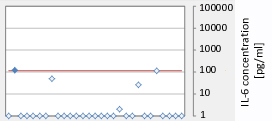Your basket is currently empty!
ProStorm® Cytokine Release Assay
ProStorm® Cytokine Release Assay
for understanding the hazard of first infusion reactions
Novel biotherapeutics can cause infusion-related reactions in patients, which may only become apparent in first-in-man trials. The FDA recommends in its definitive Guidance for Industry for Immunogenicity Assessment for Therapeutic Protein Products: “in vitro assessments of the capacity of such therapeutic protein products to mediate cellular activation, including proliferation and cytokine release in human whole blood or peripheral blood mononuclear cells are recommended” prior to first-in-man use.
The FDA also states in its recent guidance for Nonclinical Safety Evaluation of the Immunotoxic Potential of Drugs and Biologics that “an assessment of the potential for cytokine release syndrome caused by therapeutic proteins using unstimulated human cells in both plate-bound (or other assays that can assess the contribution of crosslinking of receptors) and soluble formats with appropriate positive and negative controls. These assays are considered critical for hazard identification.”
To provide more information to drug developers before drugs reach clinical trials, ProImmune has developed ProStorm®, an in vitro cytokine release assay which can help to predict the likelihood of first infusion reactions. Over several years ProStorm® cytokine release assay has been deployed on a very broad range of biotherapeutic entities, from peptides to proteins, mAbs, ADCs, bi-specifics, vaccines and more complex novel biological entities with data from the assay being submitted routinely to regulatory agencies, such as the FDA.
For complex generic peptide products following the FDA ANDA (Abbreviated New Drug Application) regulatory pathway, the sponsor must demonstrate that any impurities present in the drug product (these can be host-cell derived, direct peptide-related impurities (i.e. truncated or inserted amino acids), or other non-peptide-related impurities) are not posing risks of immune activation that can lead to innate (and adaptive) immunogenicity of the drug substance. As a sensitive whole blood assay, ProStorm® is ideally suited to address these critical and urgent questions in your product’s development. ProImmune is the global expert in this field being able to confidently support your drug development program by generating fit for purpose in vitro data in evaluating immunogenicity risk of complex peptide products as part of your regulatory submission.
With a typical core turnaround time of only 4 weeks ProStorm® is a rapid service helping you make timely decisions in your development program.
The ProStorm® key features
- Rapid turnaround with direct recruitment of study cohort (typically 20-40 donors)
- Multiple incubation formats available, e.g. whole blood in solution and plate bound
- Standard or extended range of cytokines
- Market-leading assay with many years of experience running the assay successfully across very broad range of drug-entity types
- Proven track record of many successful regulatory submissions
- Supported by our market-leading global immunology team
The ProStorm® Cytokine Release Assay in detail
 |
For best results we typically source fresh blood samples specifically for your study from a donor cohort chosen to match the needs of your project. Most often, we will use cohorts of at least 20 healthy volunteers, but we are able to source donors with known conditions if this is required. The assay can be set up with fresh whole blood and/or isolated PBMC, with drug that is either in solution or immobilized, depending on the customer requirements. We routinely perform assays in all of these formats. We use your drug preparation at a range of concentrations designed to mimic the peak exposure during a first infusion. |
|
We add your drug preparation to the blood or PBMC samples, and after incubation, harvest the serum to measure cytokine levels. Typically, we would measure TNFα, IFNɣ, IL-2, IL-4, IL-6, IL-8 and IL-10, but in consultation with you we will select the best panel. Cytokine levels are measured using our optimized immunoassay technology for accurate quantification. Our team analyses your data to give you results that can be used in informing the next stages of your research. |
|
What does a ProStorm® dataset look like?
We present two types of analysis as standard – plots showing the response from your donor cohort by cytokine for each drug/concentration, and a threshold (cut-point) analysis to indicate potential risk.
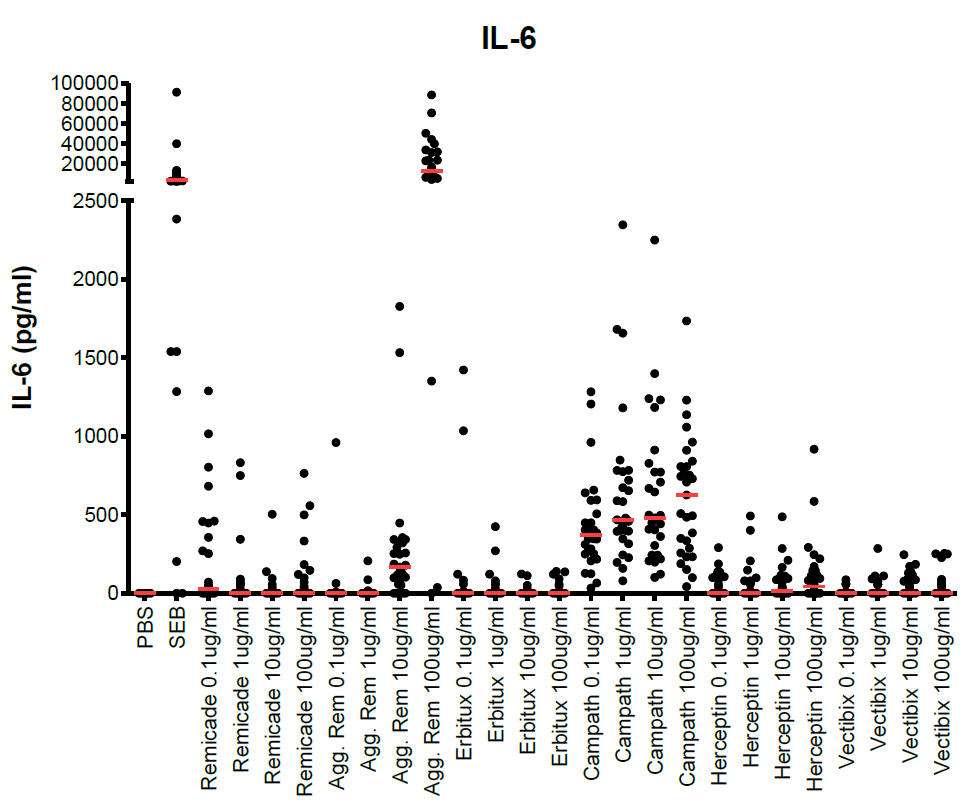
Figure 1: – Prostorm® results. Cytokine Response Data for IL-6. Responses from a cohort of 29 donors, stimulated with (left to right) Remicade®, aggregated Remicade®, Erbitux®, Campath®, Herceptin® and Vectibix®, at a range of concentrations. Medians are indicated by red lines. Particularly notable are the high responses from Campath®, and from aggregated Remicade®.
Threshold Analysis
In addition to plots showing the cytokine responses of your whole donor cohort to each drug and dose combination tested, we also present a threshold (cut-point) analysis. In this analysis the test article therapeutic is typically compared to Erbitux®(Cetuximab), as this is known to elicit a low incidence of first infusion-related reactions.
| A threshold (red line) can set based on the 95th percentile of the test cohort response a low response comparator drug. This threshold is then applied to the results from other test articles. Donor responses above threshold are clearly visible (filled blue points). |
Figure 2: example threshold analysis |
This analysis approach is particularly powerful when used across a range of drug concentrations and when used with a large donor cohort. The results shown are from 29 healthy donors, and show the IL-6 response to 100µg/ml drug.
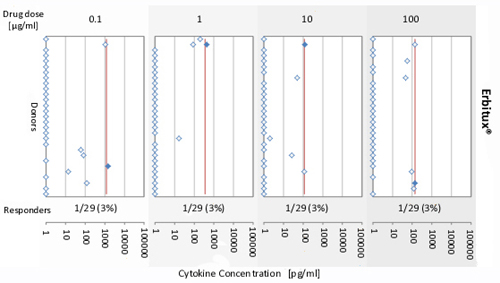
Figure 3: Erbitux® responses and 95th centile thresholds applied across increasing drug concentrations, IL-6 responses from a 29-donor cohort.
High Response Comparator
We will also typically include Campath® (Alemtuzamab) as administration of this mAb is associated with a high incidence of first-infusion reactions, and can serve as a useful high response comparator.
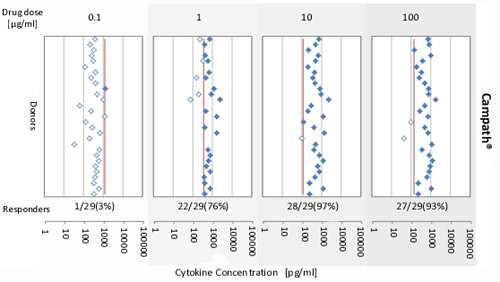
Figure 4: Campath® responses with Erbitux® 95th centile thresholds applied across increasing drug concentrations, IL-6 responses from a 29-donor cohort.
A particularly attractive feature of the assay is its suitability for assessing fully formulated therapeutics. This allows the effects of changes in formulation to be easily assessed. In one of our exploratory studies at ProImmune, we investigated the cytokine responses to Infliximab (Remicade®) and aggregated Remicade®. The results (figure 5) clearly show the increased reactivity of fresh blood to the aggregated formulation.
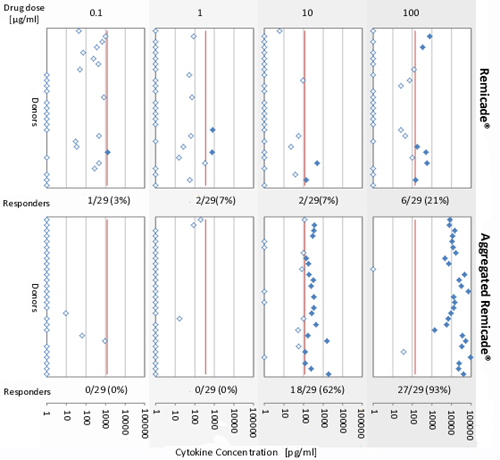
Figure 5: Remicade® and Aggregated Remicade® responses with Erbitux® 95th centile thresholds applied across increasing drug concentrations, IL-6 responses from a 29-donor cohort. Positive responders are indicated by filled data points.
Correlation of ProStorm® results with clinically observed incidence of first infusion reactions
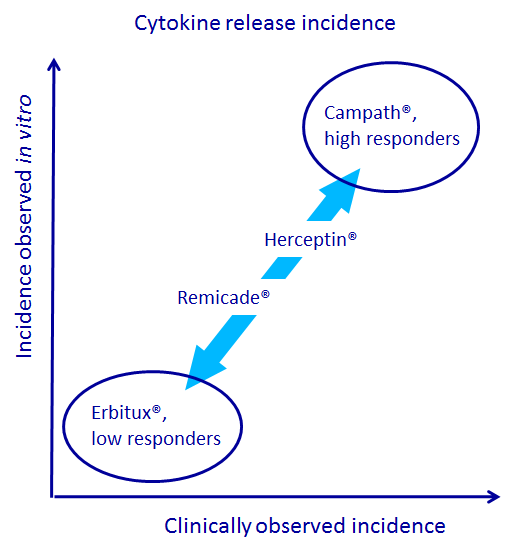
Figure 6: For a range of well known therapeutic drugs in the market place, where the clinically observed incidence of cytokine release reactions is known a good correlation is seen between the ProStorm® assay results and clinical incidence of cytokine release.
Frequently Asked Questions:
Q: Does unexpected high cytokine release in a ProStorm® project cause problems with the regulatory submission?
A: Understanding the hazard of potential cytokine release is important for any prospective clinical study. If a hazard is identified from the assay, usually numerous options are available for mitigating the hazard going into the clinic. These often include: adjusting the dose range, extending drug release time, changing mode of administration, planning for treatment of clinical effects of cytokine release, another chance to look at manufacturing / fill finish related issues (where relevant).
Q: Which cytokine release assay works best: whole blood or PBMC, soluble or plate bound?
A: The most appropriate assay format will depend on the test articles under investigation. In some situations more than one testing format is advisable and we can implement the assay formats most suitable for your compounds. Some early publications suggested that blood based assays did not produce the sensitivity of PBMC assays. Generally we find that this is not the case and our optimized whole blood assay shows very good sensitivity with commercially available drugs known to cause cytokine release. The lack of manipulation of whole fresh blood as a test system also makes this version an attractive assay variant.


